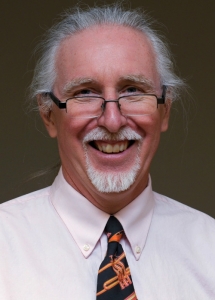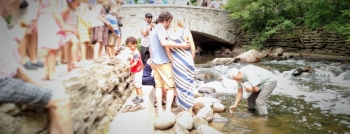 By Bob Hulteen
By Bob Hulteen
As Jim Rice, my friend visiting from Washington D.C., and I crossed the parking lot at Mary Gibbs Mississippi Headwaters Center, seeking the path down to the rocks that mark the source of the Mississippi River, we were welcomed with flies that seemed angry about the coming weather change even though this day the sun was beating down hard. We decided to seek shelter in the welcome center of Itasca State Park, and soon we were reading about the controversy over who “discovered” the headwaters, as well as learning that Mary Gibbs, at 24 years of age, was appointed the first female park superintendent of a state park in the nation.
JR located our spot on a paper mâché map of the Mississippi on what must have been a 20-foot table. We remembered that that same river runs blocks from my house, and that he and I had also stood on the banks of the Mighty Mississippi in both Saint Louis and New Orleans. This river united JR and me through the time and space of our friendship.

Contemplating that feeling of water as a unifying force, I recalled the 2016 Minneapolis Area Synod Assembly at St. Andrew Lutheran Church in Eden Prairie. Bishop Ann had invited the dean of each of the 12 synod conferences to bring a jar filled with water sourced from a river, lake, or creek within the boundaries of each conference — from North Minneapolis to Rum River, from Western Parks and Lakes to the 394 Corridor. During the assembly’s opening worship, the deans had brought their jars down to the empty font and poured out a portion of its contents, mingling together trickles from various watersheds of the synod into one baptismal pool. The image was both symbolic of our congregations gathered and a tangible glimpse of the various “shades” of water in the watersheds, requiring our attention as disciples of the One who Created.
IT IS BECOMING MORE COMMON during baptisms, I think, for congregations to include the names of waterways and watersheds important to the baptizing family in the liturgical story of God’s faithfulness. In my home congregation, as the family stands in the center aisle of the sanctuary, we hear Rio Grande or Lake Superior or Minnesota River or Red River of the North, as the infant strains to watch the water being poured into the font. We know that Jesus was baptized in the Jordan. Mixing our own story with the Biblical story reminds us all of God’s love for Creation and for each individual created.
Mixing our own story with the Biblical story reminds us all of God’s love for Creation and
for each individual created.
I had the honor of attending the installation of Pastor Regina Hassanally as bishop of the Southeastern Minnesota Synod last weekend. It was a service filled with beautiful music, inspiring words, and triumphant images, even as we together admitted the challenges that were facing the new bishop. The altar was filled with young ones of the children’s sermon and the receiving line was long, offering some sense of continued calling.
 On the 75-minute drive back to the Twin Cities, I thought about the various watersheds I was driving through from Owatonna. Wouldn’t the naming of watersheds be a great addition to the installation of each bishop in the ELCA? “From Zumbro Falls to the Root River; from Lake Pepin to the Cannon.” Such connection to water would re-enforce the commitments of our baptism even as our new bishops are beginning their new calls. God’s promises in baptism then become the assurance of God’s presence in the ministry of the bishop. Recognizing our connection to the created order even as we celebrate new leadership and new opportunities could be a watershed moment for our church and for the world.
On the 75-minute drive back to the Twin Cities, I thought about the various watersheds I was driving through from Owatonna. Wouldn’t the naming of watersheds be a great addition to the installation of each bishop in the ELCA? “From Zumbro Falls to the Root River; from Lake Pepin to the Cannon.” Such connection to water would re-enforce the commitments of our baptism even as our new bishops are beginning their new calls. God’s promises in baptism then become the assurance of God’s presence in the ministry of the bishop. Recognizing our connection to the created order even as we celebrate new leadership and new opportunities could be a watershed moment for our church and for the world.

